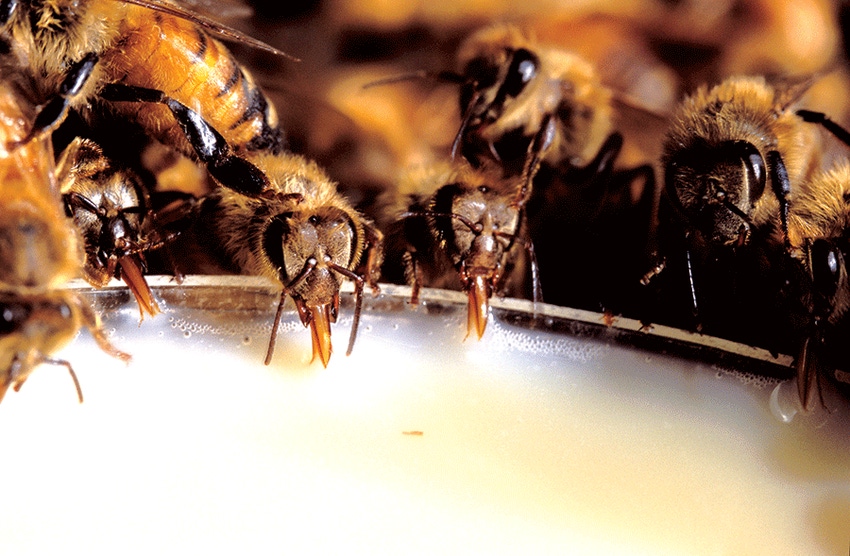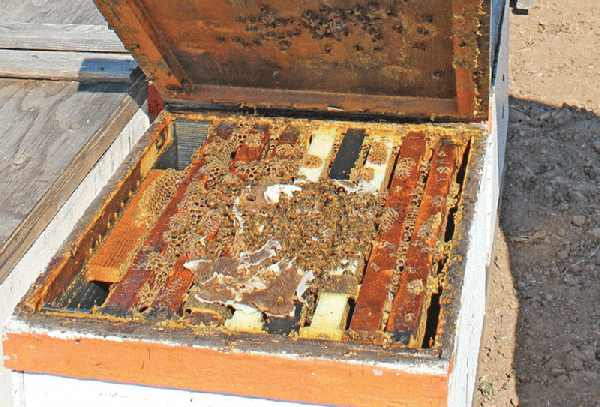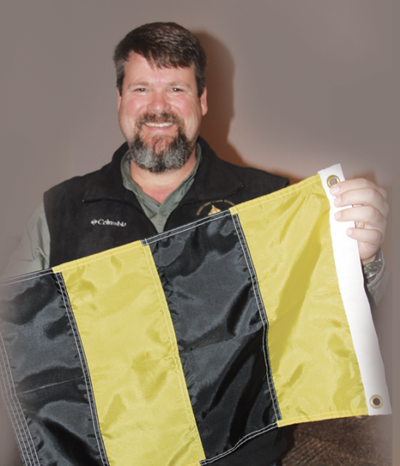
Third in a series
Despite widespread condemnation of ag pesticides — particularly neonicotinoids — by activist groups and the national media as the culprit in the death of millions of honey bees, bee expert Jeff Harris says, “I�’ve seen no data, or metadata, linking huge losses of honey bees in the U.S. to any single insecticide, neonicotinoid or otherwise.

“The national politics surrounding the issue of bees and pesticides has become ugly," says Jeff Harris. "It has become a chess match."—Mississippi State University photo
“The national politics surrounding the issue of bees and pesticides has become ugly," says Jeff Harris. "It has become a chess match."—Mississippi State University photo“There are no big data sets to support that pesticides are the leading cause of Colony Collapse Disorder,” says the Mississippi State University Extension/Research Apiculturist, who has worked with honey bees since boyhood and was a member of the team that developed a honey bee line with resistance to the varroa mite that’s a vector of viruses that have wiped out thousands of bee colonies in the U.S. since the pest was first documented in this country in 1987.
“Certainly, you can do experiments in the lab or in semi-field plot tests to show these materials kill bees, or adversely affect their physiology,” says Harris, who spent 15 years as a bee breeder and researcher at the USDA Honey Bee Laboratory at Baton Rouge, La., before coming to MSU three years ago.
The bigger question, he says, is what’s happening in the field?
“Anytime there has been a really good experiment with field-relevant dosing, they haven’t been able to kill bees with neonics. There have been university studies in which researchers killed honey bees with neonics, but they did it by inflating the field-relevant dose —they cranked up the dose 10 times or more and finally killed the bees. Then it hit the headlines that neonics kill honey bees. But it wasn’t at field relevance.”
IT’S FREE! Stay informed on what’s happening in Mid-South agriculture: Subscribe to Delta Farm Press Daily.
Neonicotinoid seed treatments can kill bees, Harris says, through direct acute toxicity from planter dust drifting onto bee colonies at field edges or onto the flowers that bees contact.

Because neonicotinoid dust from corn planting can kill honey bees, changes have been made to practices and equipment to minimize the risk.—Photo: John Deere
Because neonicotinoid dust from corn planting can kill honey bees, changes have been made to practices and equipment to minimize the risk.—Photo: John Deere“This happens most frequently with dust from corn planters, and was first described by Christian Krupke at the Purdue University Bee Laboratory, who found that when pneumatic corn planters generate clouds of neonicotinoid dust, and the dust drifts onto beehives near the field edges or lands on blooming flowers that bees are working, it can kill the hive.
“This can be prevented. Manufacturers have changed talcs and lubricants, they’re putting manifolds on planters, and beekeepers are moving bees away during the planting period.”
Neonicotinoids and pollen/nectar
Because neonicotinoids are systemic and are absorbed into plant tissues from treated seed, there is the question: Does the pesticide appear in the pollen and nectar of corn plants?

Corn pollen and nectar aren't very nutritious for honey bees, says Jeff Harris, but in cases where other sources aren't available, they will work corn.
Corn pollen and nectar aren't very nutritious for honey bees, says Jeff Harris, but in cases where other sources aren't available, they will work corn.Yes, Harris says. “Bees do get it if they’re working corn fields. We [Harris and entomologists from three Mid-South states, including Drs. Angus Catchot, Jeff Gore, and Don Cook from MSU] haven’t been able to find it in soybean flowers, and in only one cotton flower sample, nor have we found it in the nectar of cotton or soybeans.
Work is in progress in Mississippi, Tennessee, Arkansas, and elsewhere, looking at neonicotinoid seed treatments and their effects on honey bees, and at the decay of the materials in the plant as it grows.
“Adam Whelan, a Ph.D. student, and a group here at MSU are looking at soybeans, cotton, and corn,” Harris says, “and their findings indicate that by the time you get to the flowering stage of cotton and soybeans, there’s almost no neonic in the plant tissue. The only crop with consistent neonic in the pollen is corn.
“In terms of seed treatments in Southeast crops — especially soybeans and cotton — we think the risk from neonics is pretty low. In the Midwest, they’re seeing the expression of neonics in corn pollen, and if bees were to work the crop, there could be more of a risk to them.”
Corn pollen is not very nutritious for honey bees, he notes, “but they will go to it. In the Midwest, when corn is tasseling, there’s not much else bees can work, so they go to corn. But I’m not aware of anyone reporting bee kills related to corn planter dust or expression of neonics in corn pollen.”
Mississippi beekeepers, Harris says, mostly place their hives in soybeans and cotton, “because those crops make nice honey, and a lot of it. While honey bees don’t really like cotton flowers — they can’t pack cotton pollen well — they do like to collect nectar from the non-floral nectaries.”
Neonicotinoids are also used as foliar sprays, he points out, “and I have no doubt if you spray flowers and bees work those flowers, there could be substantial risk. There’s a lot of investigative work going on in these areas.”
But, says Harris, “I still contend there hasn’t been a study to establish that neonic seed treatments, in an agricultural environment, are a huge ecological risk to honey bees. In general, at the doses being used in agriculture, it looks like neonics may not be very harmful to honey bees — but that doesn’t speak to native bees or other pollinators. So, we can’t say it’s completely innocuous to all bees.”
Some tank mixes can be a problem
There are certain situations, he says, where “it has been clearly demonstrated that certain tank mix applications are dangerous to bees. The clearest example is in almonds in California, where molds tend to occur in foggy, wet conditions, and a lot of growers apply a fungicide, an insect growth regulator, and another insecticide, all in the same tank mix, during bloom. That combination can be lethal to bees.”

Colony Collapse Disorder, which has wiped out honey bee colonies in the U.S., Europe, and elsewhere is predominantly caused by diseases vectored by the tiny varroa mite.
Colony Collapse Disorder, which has wiped out honey bee colonies in the U.S., Europe, and elsewhere is predominantly caused by diseases vectored by the tiny varroa mite.Harris says, “Beekeepers call me and say they have Colony Collapse Disorder, and when I go and investigate, they’re located in a non-agricultural area, but say ‘Pesticides killed my bees’. And my question is, pesticides from where?
“Our biggest commercial beekeepers in Mississippi — the ones who make the most honey — take their hives to Delta soybean fields year-in and year-out, where growers may make 8 or 10 pesticide applications during a season. Beekeepers have learned how to mitigate the risk. Working with farmers, they’ve have learned how to put their bees in locations where exposure to pesticides will be as low as possible.
“I’m not saying the risk is zero; I’m saying beekeepers who go into those agricultural environments know the risk, and they’re mitigating it as much as possible to allow them to make high yields of honey — some are getting well over 100 pounds of honey per colony from Delta crop fields, and that’s much above the national average.”
Check current commodity prices

Mississippi Extension Entomologist Angus Cachot holds a Bee Aware flag that's used to help pesticide applicators avoid accidentally spraying bee hives.
Mississippi Extension Entomologist Angus Cachot holds a Bee Aware flag that's used to help pesticide applicators avoid accidentally spraying bee hives.In 2014, the USDA’s National Agricultural Statistics Service reported Mississippi’s honey yield average led the nation, at 112 pounds per colony, with a value of $4.5 million.
The Mississippi Honey Bee Stewardship Program (some think of it as the ‘Bee Aware’ flag program), aimed at heightening awareness of bee hives when pesticide applications are being made, was originated in Mississippi and similar plans have been adopted by other states.
“I think it has increased awareness of pollinator issues among farmers and beekeepers,” Harris says. “We all realize the need for these two groups to have a beneficial dialogue — for beekeepers to fully understand the pest management problems of the farmer, and for the farmer to understand that his pesticide applications are a potential risk to honey bees, with both parties doing their best to minimize risk.
Farmer/beekeeper communication important
“We have to keep plugging at it: increasing the dialogue, farmers knowing exactly where bees are located, and beekeepers doing a better job of hive placement on the farm is important. The Bee Aware flags and program are helping to do that.”

Because Mississippi row crop farmers don’t need bees for pollination of their crops, Jeff Harris says, “there’s going to continue to be a need for understanding, cooperation, and communication on both sides.â€â€”Photo: Mississippi State University
Because Mississippi row crop farmers don’t need bees for pollination of their crops, Jeff Harris says, “there’s going to continue to be a need for understanding, cooperation, and communication on both sides.â€â€”Photo: Mississippi State UniversityIn general, Harris says, “I don’t think we have a real problem with pesticides and bee kills in Mississippi, given the many bee colonies that are placed in the Delta each year. During the time I’ve been in Mississippi, I can think of only one reported incident of bees killed by drifting insecticide spray, and that event probably resulted from poor communication between beekeeper and farmer. I’m not aware of any other reported bee kills in the last five years.”
In Mississippi, he notes, beekeepers aren’t required to register their colonies, “so there’s really no way to track losses. Commercial beekeepers are secretive — they don’t want anyone to know how many colonies they have, and they’re very protective of their locations. For the most part, loss numbers are self-reported and are not independently verified, so there’s not much way to get really good mortality data.”
Unfortunately, says Harris, “The national politics surrounding the issue of bees and pesticides has become ugly — it has become a chess match. The lawsuit by beekeepers over sufloxaflor was the straw that broke the camel’s back for some farmers.
“For example, in one Mississippi county, several farmers were upset about the national lawsuit that took away a tool they needed for control of the sugarcane aphid, and they reacted by throwing a commercial beekeeper off their lands — and the beekeeper wasn’t involved in the lawsuit.
“But the farmers wanted to make a statement: ��‘Our crops don’t need beekeepers, and if they’re going to sue us, we don’t want them on our land’. Angus Catchot [Mississippi Extension professor of biochemistry, molecular biology, entomology, and plant pathology) and I, our department head, and Farm Bureau representatives met with both sides, and they vented and were able to work things out.”
But, Harris says, because Mississippi row crop farmers don’t need bees for pollination, “there’s going to continue to be a need for understanding, cooperation, and communication on both sides.”
(Our next article: The amazing honey bee and its role in agriculture.)
About the Author(s)
You May Also Like




